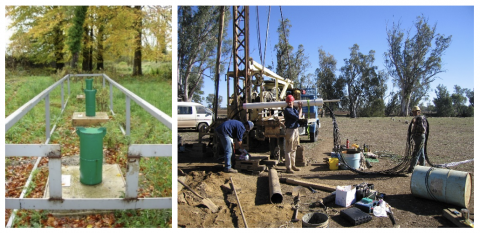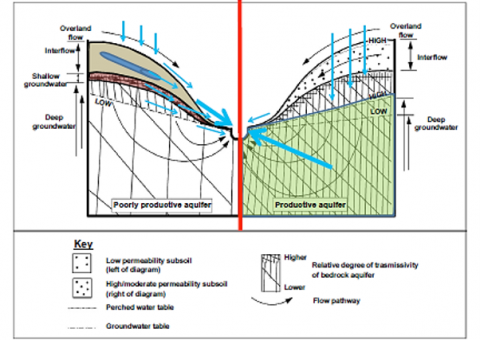- What are priority parameters?
-
Priority contaminants include salinity (usually monitored as electrical conductivity, EC), acidity (pH), major ions, nitrate, microbiological pollutants, contaminants of emerging concern (CECs – pharmaceuticals, etc) and geogenic parameters, notably arsenic, iron, manganese, fluoride and radionuclides. However, a major question is: what groundwater quality parameters can be brought into a global water quality assessment, which are scientifically sound and can easily be “upscaled” to a global assessment, while bearing in mind that many/most groundwater quality issues are local? The work of the GEMS/Water project in contribution to the UN-Water Integrated Monitoring Initiative focused on SDG 6.3.2 (ambient water quality) is relevant here: the core groundwater parameters are EC, pH and nitrate, whilst the full set constituting this indicator parameters also include phosphate and oxygen relevant in addition in surface waters.
Whatever parameters are monitored, it is essential to ensure that the data are as accurate and reliable as possible. This includes using appropriate field and laboratory sampling, storage and analysis methods; applying proper quality assurance protocols; taking care in data entry and data transfer within and between databases, etc. Often laboratories performing the chemical analysis are accredited and have established quality procedures. However, the field sampling and analysis rarely has this level of quality assurance. Frequently forgotten in the context of sample quality is the suitability and condition of site infrastructure (bores or wells) for sample integrity.
- Upscaling local studies to regional assessments
-
Many pollution sources are localised, in addition to the significant natural variations in geology and hydrogeology across the aquifer systems of the planet. This means that pollution impacts on wells are often site-specific, making regional upscaling of results difficult.
Local studies will need to be upscaled to regional assessments, but how should this be done? There are some potential ways forward, for instance the Swiss Federal Institute of Aquatic Science and Technology (EAWAG) proposed a machine-learning approach at a larger, possibly global level (see Section 5.1). Machine learning has been also used at the African scale with good results, for geogenic contaminants such as fluoride. These types of approaches still require more research before they can be applied at a global scale for contaminants introduced, or at least mobilised, by human activities, including salinity (EC), chloride, microbes, nitrates, phosphorus, trace metals, trace organic compounds, etc.
- The 3rd (3-D flow) and 4th (time) dimensions
-
Image

Cluster of boreholes to monitor groundwater level and quality at different depths (left), Multi-level sampling device being installed at a site in Australia (right) One major complexity of assessing groundwater quality arises from the 3-D nature of flow systems. Groundwater systems are often highly heterogeneous, meaning that samples from wells in close proximity may produce very different results, especially if they are taken from different depths. Well construction may also impact on the groundwater quality data: for example, two wells of identical depth may produce contrasting groundwater quality results if one of them is constructed with a grouted upper well casing and the other is not. It is therefore necessary to monitor groundwater quality at different depths using special borehole designs such as clusters, piezometer nests or using multi-level devices.
The impact of the 3-D nature of groundwater flow on pollution pathways is illustrated in the following figure. On the left-hand side of the diagram, the geology comprises a low transmissivity, poorly productive fractured bedrock aquifer overlain by clayey soils and subsoils. Here, flow pathways and hence pollutant transport mainly occurs in the shallow fractured and weathered bedrock layers, or in local permeable zones within the subsoils. On the right-hand side of the diagram, in contrast, the subsoils and aquifer are more permeable, and contaminants may follow deeper pathways. The design of the monitoring system must thus take account of these hydrogeological and contaminant characteristics.
Image
Contaminant pathways present in low transmissivity poorly productive aquifers Other complexities are the long transport times involved in many groundwater flow systems. Groundwater pollution and rehabilitation may take place over considerably longer timescales than a surface water contamination problem. For example, nitrate currently stored in the unsaturated zone may result in contamination of the underlying aquifers for many decades. Thus, present day land use and industrial practices may leave long-term legacy issues relating to groundwater pollution. As well as long term issues, groundwater quality may vary seasonally, or respond to local short-term rainfall. Microbiological contamination of wells, for example, is often closely related to individual rainfall events. Hence monitoring programs should be designed to collect groundwater quality data at the required frequency to show the temporal changes.
- Poor sampling or analysis procedures; poor monitoring well construction
-
For river systems, sampling downstream along the river gives an integrated picture of the water quality pressures from the catchment, but this is not the case with groundwater systems. Often boreholes designed for monitoring water levels are subsequently adopted for measuring water quality, even though their location and construction may be unsuitable or suboptimal for this purpose. Moreover, groundwater sampling data may be unrepresentative because of poor sampling or analysis procedures.
Boreholes for monitoring groundwater quality need to be sited carefully, and to be constructed to permit collection of water samples at the required depth intervals. The construction materials, sample collection and handling procedures must be chosen to avoid reporting “false positives” and “false negatives”. This is especially important when dealing with contaminants that are redox sensitive (unstable in air), volatile or present in groundwater in trace concentrations, including the contaminants of emerging concern. The materials therefore must not sorb contaminants from the water sample, nor leach contaminants. Field personnel need to be trained to a high level to ensure that they can obtain representative samples.